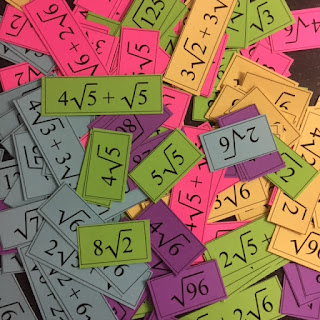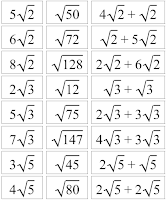
This is supposed to be a quick introduction activity to mixed radicals. Rather than just tell students what mixed radicals are and how they behave, we would start with these and have them explore first and then consolidate afterwards. There are four groups of cards where each group has a different "root" radical. Within each group there are three sets cards that are all equal in value but different in form. Students have to arrange group the cards that are equal and hopefully come up with the connection between a radical in different forms. There is a physical card version as well as a Desmos Cardsort version.

- MCR3U - verify, through investigation with and without technology, that √ab = √a x √b, a ≥ 0, b ≥ 0, and use this relationship to simplify radicals (e.g., √24) and radical expressions obtained by adding, subtracting, and multiplying

- If you are using the physical version, we recommend printing each set of cards (2 pages) on a different colour of cardstock. This makes it easier to group the cards afterwards since each group will be a different colour. We also suggest laminating the cards before cutting.
- You may wish to print out one copy of the full two sheets back to back for yourself as an answer key.
- If you are using the Desmos version, make a copy of the activity and create your class code for students.

- Put students into groups of 3 (or four). Using larger groups will make this activity go faster but will mean that students do less.
- Ask students to determine all the expressions that are equal to each other. Because this is an intro activity and students don't know the properties of mixed radicals, let them use calculators. It is optional to tell them that there are a total of 12 sets of three cards that are equal. If you are pressed for time you might take some of the sets out.
- Once students have found all of their matches ask them to further group those sets of three in any way they wish. Hopefully they will put them into four groups with the same "root" radical.
- As further extensions
- You may wish to ask some of the questions, below, from the Desmos cardsort (there are even more there) to pull out the nature of mixed radicals.
Did you use this activity? Do you have a way to make it better? If so tell us in the comment section. Thanks



